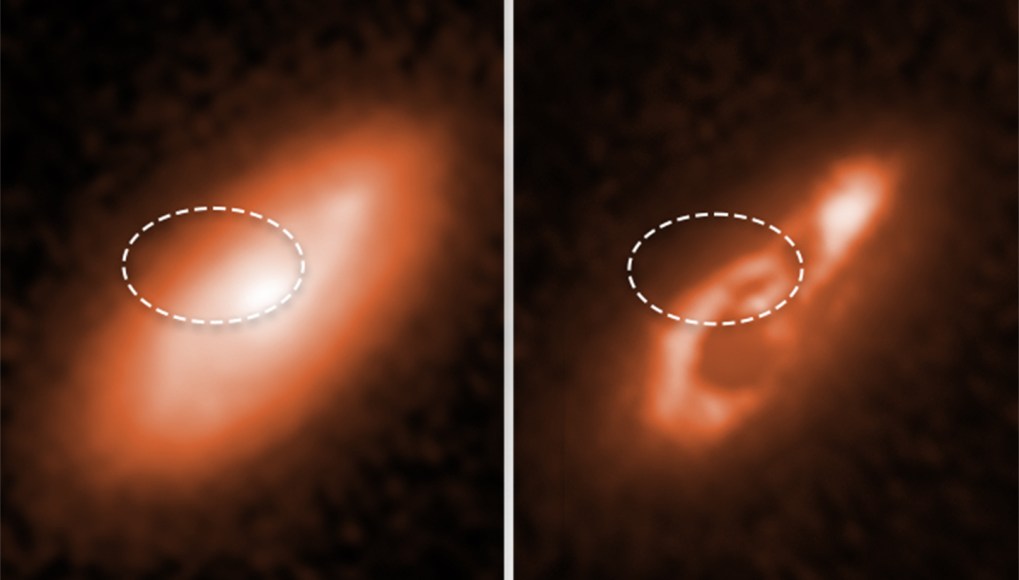Some fast radio bursts come from the spiral arms of other galaxies
Locating the bursts’ homes suggests a connection to ordinary, young stars

A Hubble Space Telescope image (left) of a galaxy known to host a ‘fast radio burst’ helps ID where in the galaxy the blast originated (oval). After image processing (right), the burst’s origin appears centered on one of the galaxy’s spiral arms.
NASA, ESA, Alexandra Mannings/University of California Santa Cruz, Wen-fai Fong/Northwestern University, Alyssa Pagan/STScI
- More than 2 years ago
Five brief, bright blasts of radio waves from deep space now have precise addresses.
The fast radio bursts, or FRBs, come from the spiral arms of their host galaxies, researchers report in a study to appear in the Astrophysical Journal. The proximity of the FRBs to sites of star formation bolsters the case for run-of-the-mill young stars as the origin of these elusive, energetic eruptions.
“This is the first such population study of its kind and provides a unique piece to the puzzle of FRB origins,” says Wen-fai Fong, an astronomer at Northwestern University in Evanston, Ill.
FRBs typically last a few milliseconds and are never seen again. Because the bursts are so brief, it’s difficult to nail down their precise origins on the sky. Although astronomers have detected about 1,000 FRBs since the first was reported in 2007, only 15 or so have been traced to a specific galaxy.
The first burst to be traced to its source came from a small, blobby dwarf galaxy with a lot of active star formation (SN: 1/4/17). That FRB sends off repeated blasts from a single source, which is an unusual feature, and helped astronomers localize its host galaxy.
“After that, a lot of people thought, well, maybe all FRB hosts are like this,” says astronomer Alexandra Mannings of the University of California, Santa Cruz. But then a second repeating burst was tracked back to a spiral galaxy like the Milky Way (SN: 1/6/20). And a one-off burst was localized to a massive disk-shaped galaxy, also the size of the Milky Way. Others followed.
Mannings, Fong and colleagues thought they could learn more about the FRBs’ sources by localizing their origins even more precisely. Different parts of spiral galaxies tend to host different types of stars. The bright spiral arms tend to mark sites where new stars are being born, while the older and dimmer stars have had time to drift away from the arms into the rest of the galaxy. So figuring out which galactic neighborhoods FRBs call home can reveal a lot about what kind of objects they come from.
Using the Hubble Space Telescope, the researchers took high-resolution images of eight galaxies that were already known to host FRBs, then overlaid the FRBs’ positions onto the images. The five FRBs that came from clearly defined spiral galaxies all lay on or close to the galaxies’ spiral arms, which had not been visible in images from ground-based telescopes. The other three host galaxies had inconclusive shapes, Fong says.
The FRB locales have a fair amount of star formation, but they’re not the brightest and most active parts of their galaxies, Fong says. That suggests FRBs originate with ordinary young stars — not the youngest, most massive stars that occupy the brightest knots in the spiral arms, but not the oldest and dimmest stars that have drifted away from their homes, either.
That finding is consistent with the idea that FRBs come from highly magnetized stellar corpses called magnetars, Mannings says (SN: 6/4/20). There are a couple of ways to produce magnetars from ordinary stars. There’s the slow way, which involves waiting billions of years for a pair of neutron stars to collide (SN: 12/1/20). Or there’s the fast way, which follows the death of a single massive star. It seems like FRBs might come from an in-between process, like the death of a not-so-massive star, Mannings says.
“The fact that FRBs are found to be pretty close to, if not on, the spiral arm, near to these star forming regions, that can give us a better idea of what the timeline is like for the progenitor,” whatever created the FRB, Mannings says. “And if it is a magnetar, it lets us know that it’s not through the delayed channel, like a neutron star merger.”
The finding doesn’t entirely solve the mystery of where FRBs come from, says astrophysicist Emily Petroff of the University of Amsterdam, who was not involved in the new work. But it does help to get a broader picture of their host galaxies.
“FRBs keep throwing a lot of surprises at us, in terms of what they look like, where they’re found, how they repeat,” Petroff says. “This is maybe providing more evidence that FRBs are more related to just sort of general neutron stars.” The next step, of course, is to find more FRBs.







